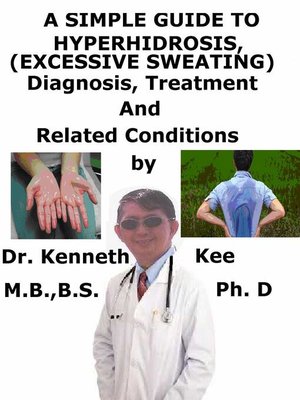A Simple Guide to Hyperhidrosis, (Excessive Sweating) diagnosis, Treatment and Related Conditions
ebook
By Kenneth Kee

Sign up to save your library
With an OverDrive account, you can save your favorite libraries for at-a-glance information about availability. Find out more about OverDrive accounts.
Find this title in Libby, the library reading app by OverDrive.



Search for a digital library with this title
Title found at these libraries:
| Loading... |
This book describes Hyperhidrosis, Diagnosis and Treatment and Related Diseases
I have a patient who almost always complained of sweaty hands and soles.
He always refuses to shake hands with everyone.
His clothes are always drenched with sweat.
He said that it was embarrassing both in appearance and at work using his hands to write.
I have advised him to use aluminum chloride solution to dry up his hands and feet temporarily or to go for laser or surgical treatment if the disorder does not improve.
Aluminum chloride solution is sold over the counter at pharmacies: Drysol Astringent Solution or Powder Packets
Sweat is the body's natural air conditioner, through which humans regulate the temperature.
Hyperhidrosis is excessive, bilateral, and generally symmetric sweating that is not triggered by activity or environmental factors.
The quantity of sweating is least 4-fold higher than the quantity required for cooling off.
Hyperhidrosis is a disorder of excessive sweating caused by the over stimulation of cholinergic receptors on eccrine glands.
This disorder is featured by sweating beyond what the body utilizes for homeostatic temperature regulation.
Eccrine glands are found in large quantities in areas such as the axillae, palms, soles, and face
These are the areas most often linked with hyperhidrosis.
The acetylcholine negative feedback loop is probably affected in these patients, which may help explain how a physiological reaction can become pathological.
The palmar region is the most often involved area.
There are 2 types of hyperhidrosis: primary focal and secondary generalized.
Primary focal hyperhidrosis is excessive focal sweating of at least 6 months' duration without any clear cause and with at least two of these features:
Onset as early as age 9 years;
Bilateral and symmetric pattern;
Impairment of daily activities;
Occurrence at least once per week;
Cessation during sleep; and
A positive family history (reported by two thirds of patients).
The precise cause of primary hyperhidrosis is not known.
Genetic factors are thought to play a part in excessive neural stimulation.
If the sweating can be blamed on an underlying medical condition, it is called secondary hyperhidrosis.
Secondary generalized hyperhidrosis normally starts in adulthood.
It can be produced by drugs, toxins, or substance abuse and can be linked with cardiovascular disorders, respiratory failure, infections, and malignancies such as Hodgkin lymphoma, myeloproliferative disorders and cancers with catabolism.
It can also be produced by endocrine/metabolic disorders, such as thyrotoxicosis, pheochromocytoma, acromegaly, carcinoid tumor, hypoglycemia and menopause.
This type of hyperhidrosis is more prone to induce sweating all over the body.
Hyperhidrosis can cause emotional, psychological, social, and occupational affliction.
Hyperhidrosis is unusually excessive sweating that is not necessarily linked to higher temperatures or exercise.
The person may sweat so much that it drenches through the clothes or drips off the hands.
Besides disturbing normal daily activities, hyperhidrosis can produce social anxiety and cause embarrassment.
Hyperhidrosis treatment normally requires prescription-strength antiperspirants on the affected regions.
For persistent hyperhidrosis, the person may need to try different medicines or other therapies.
In severe cases, the doctor may propose surgery either to remove the sweat glands or to detach the nerves causing the excessive sweat.
TABLE OF...






